News
Air pollution can make kids behave badly
Wednesday, December 13, 2017
When wildfires started raging through southern California this month, Diana Younan warned her family members living in the path of the smoke to stay inside, as much as possible. Fires send air pollution levels soaring, filling the air with tiny particles. Younan, who studies environmental health at the Keck School of Medicine at the University of Southern California, knows the damage those tiny particles can do.
“It’s very well known that air pollution can affect respiratory function or health. But it’s not as well known that it can also affect the brain,” says Younan. Over the past decade, scientists started to note mounting evidence that suggests inhaling polluted air is toxic to the brain. That is slowly being linked to behavior, particularly for children and adolescents.
It’s similar, Younan says, to the way childhood exposure to lead—which used to be used in paint and gas—was eventually connected to behavioral problems. Some scientists even suspect that the decline in crime seen in the U.S. (and many nations) since the 1990s can be connected to the removal of lead from gasoline. “Lead is what pioneered the whole research on environmental risk factors,” she says.
In an analysis of data from nearly 700 children, Younan and her team found that kids in Los Angeles who were exposed to more air pollution over the course of adolescence were more likely to engage in delinquent behavior. The research was published today in the Journal of Abnormal Psychology. It also found that the same amount of pollution exposure had a stronger effect on behavior when kids had bad relationships with their parents, or when their mothers exhibited signs of depression.
Deborah Cory-Slechta, a professor of environmental medicine at the University of Rochester who wasn't involved in the new study, started her career by looking at lead exposure. But in the past few years, she’s moved towards research on air pollution. At the beginning, she was skeptical that pollution could impact the brain. “But it was amazing what we started to find,” Cory-Slechta says. “Everyone has been surprised, to say the least, at how dramatic some of these effects can be.”
Cory-Slechta studies the effect of air pollution on animal models, and says that the behavioral changes she sees in those studies seem to match onto the type of delinquent behavior observed in Younan’s longitudinal study. “Even at relatively low levels of exposure [in animals], we see changes in behavior,” Cory-Slechta says. “Things like impulsivity, which can relate to delinquent behavior.”
Matthew Rand Discusses Recent Mercury Research
Thursday, December 7, 2017
Q&A: A Fishy Formula for Measuring Mercury
Fish are loaded with protein, fatty acids, vitamins and minerals that are important for brain development and overall health. Unfortunately, some fish are also high in methylmercury, a toxicant that impairs brain development in young children, infants and developing fetuses. The US Food and Drug Administration and Environmental Protection Agency issue fish consumption advisories to prevent mercury poisoning, but Matthew D. Rand, Ph.D., associate professor of Environmental Medicine at the University of Rochester Medical Center, believes those advisories could be more accurate.
Rand sat down with me to talk about mercury toxicity and how his new method of measuring methylmercury could improve fish consumption guidelines.
Q: What is the current EPA Fish Consumption Advisory?
A: The EPA fish consumption advisory acknowledges the health benefits of nutrients in fish, but their recommendations for amounts of fish to eat are formulated solely on the concerns for methylmercury exposure. The EPA advisory recommends that women and children should eat two to three servings (8-12 ounces for those over 10 years of age, smaller amounts for younger children) each week of a variety of fish and shellfish that are low in methylmercury. A guide from the EPA and US Food and Drug Administration shows which fish are fine to eat and which to avoid.
Q: How does the EPA create these advisories?
A: The advisories are based on a "reference dose for chronic oral exposure", which refers to the amount of methylmercury that can be safely consumed. The EPA estimates the amounts of fish that can be eaten per week, by combining this reference number with knowledge of how much mercury is present in certain fish species.
There is great concern, however, about how the reference dose is derived. People vary broadly in how they metabolize methylmercury, meaning some people clear the toxicant faster than others. Since this variation is not well studied, the EPA errs on the safe side, building a safety factor of 10 into the reference dose. This could mean the fish advisories are stricter than necessary.
Q: You just published a study showing a new way to measure mercury in people. How could this improve the EPA guidelines?
A: Our study showcases our new method to determine how fast an individual metabolizes and eliminates methylmercury from their body after eating just three fish meals. We directly measured methylmercury elimination using a single hair from each study participant. This gave us personalized methylmercury elimination rate results, which could help create a more scientifically sound reference dose formulation and more tailored fish consumption recommendations.
Q: How are you carrying this research forward?
A: There is currently almost no data for methylmercury metabolism rates for the most vulnerable populations: pregnant women and young children. Our method will enable us to make these measurements using the current EPA fish consumption guidelines and could help refine the EPA advisory using a reference dose specific to pregnant women and children.
We will also explore the role of the gut microbiome in methylmercury metabolism in people. We expect that changes in the gut microbiome, for example using probiotics, could speed up methylmercury elimination rates. We hope to begin this study in the coming year.
Matthew D. Rand, Ph.D., has studied the methylmercury and its effects on the developing nervous system for over a decade. Some of his current projects involve understanding the molecular, cellular and genetic mechanisms of neural development responsible for variation in tolerance or susceptibility to methylmercury toxicity.
Susanne Pritchard Pallo | 12/6/2017
Study will Explore Air Pollution’s Impact on the Developing Fetus
Friday, October 6, 2017
New research will seek to understand the biological mechanisms that are triggered by exposure to air pollution during pregnancy and lead to lower birth weight in newborns, placing them at greater risk for chronic conditions such as coronary heart disease and hypertension later in life. The research will be conducted in Beijing by an international team of researchers.
Air pollution is a significant global public health risk and is estimated to contribute to 3.2 million premature deaths per year. According to the World Health Organization, 9 out of every 10 people across the globe, including 100 million Americans, breathe unhealthy air.
The new $2.49 million National Institute of Environmental Health Sciences-sponsored study will be led by David Rich, Sc.D., M.P.H., an associate professor in the University of Rochester Medical Center (URMC) Department of Public Health Sciences, and Jim Zhang, Ph.D., with Duke University.
The study builds upon research conducted by the team during the Beijing Summer Olympics in 2008. That study looked at birth weights of children from mothers whose late-term pregnancy coincided with the Chinese government’s extraordinary efforts to reduce air pollution during the Games. They found that these newborns were, on average, 23 grams heavier than those born during the period immediately before and after the games when the air pollution levels were much higher.
Dr. Georas joins the NIH Precision Interventions for Severe and Exacerbation Prone Asthma (PrecISE) Network
Tuesday, October 3, 2017
Dr. Georas has joined the NIH Precision Interventions for Severe and Exacerbation Prone Asthma (PrecISE) Network. This new NIH initiative will establish a network of 10 Clinical Centers in the U.S. conducting innovative research using adaptive clinical trials. Dr. Georas serves as Steering Committee chair, with co-chair Dr. Rosalind Wright.
Doctors Might FINALLY Be Able to Tell If Your Infection Is Bacterial or Viral
Monday, August 14, 2017
If you head to your doctor with a fever and cough or other signs you're getting sick, there's a good chance your doctor won't know what's behind it. It's hard to test for certain diseases, like bacterial pneumonia.
When patients come in with respiratory viruses like the common cold and sinus infections, doctors often send them home with an antibiotic prescription. The problem is, antibiotics only target bacteria and won't do anything to fight a virus. Still, about 30 percent of antibiotics prescriptions are for viral infections, according to the CDC. (Make sure to ask these essential questions before taking antibiotics.)
Not only is an antibiotic completely unhelpful against a virus, but it could have major consequences. Antibiotics kill most of the bacteria behind your infection—but not all of them. The bacteria that are strong enough to survive will multiply to create more bacteria that are resistant to treatment, too. Over time, this means there will be more resistant bacteria than ones that antibiotics can kill, so the infections will be harder to treat.
And if you take antibiotics when you don't need to, or use antibacterial soap, you're speeding that process along. Eventually, diseases that used to be easy to treat with antibiotics could become dangerous again.
Luckily, researchers might have found a way to tell the difference between bacterial and viral infections, so you won't get a useless antibiotic. In a study in the journal Scientific Reports, researchers took blood from 94 patients who had lower respiratory tract infections. Lab tests found genetic markers in the blood that could correctly figure out if an infection was viral or bacterial 80 to 90 percent of the time. (Find out how genetic tests could help you lose weight, too.)
Because the sample size was so small, more tests will be needed before doctors can start using this diagnosis method in their offices. But if it does take off, it will be a lot easier than testing for specific diseases.
"Our genes react differently to a virus than they do to bacteria," says study co-author Thomas Mariani, PhD, pediatrics, environmental medicine, and biomedical genetics professor at University of Rochester Medical Center, in a statement. "Rather than trying to detect the specific organism that's making an individual sick, we're using genetic data to help us determine what's affecting the patient and when an antibiotic is appropriate or not."
In the meantime, if you think you're not feeling well, use these natural remedies for cold and flu.
Franchini and Meyers Win Awards
Friday, August 11, 2017
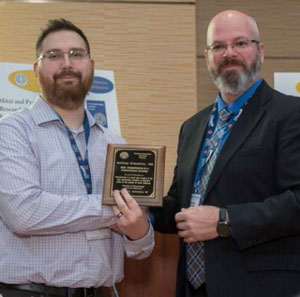
Anthony Franchini, Ph.D.
Congratulations to Anthony Franchini, Ph.D. and graduate student Jessica Meyers for both winning awards this year. Dr. Fanchini won two awards, Health and Environmental Sciences Institute (HESI) Immunotoxicology Young Investigator Travel Award and Best Presentation by a Postdoctoral Trainee Award, for his presentation, "Identification of novel gene targets of the aryl hydrocarbon receptor in dendritic cells in the context of viral infection."
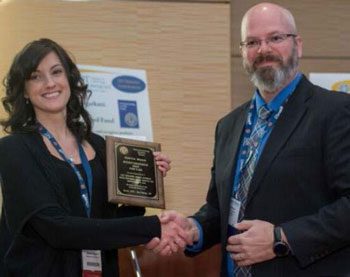
Jessica Meyers
Jessica won 1st place for Best Presentation by a Student, for her presentation "Aryl hydrocarbon receptor activation during development reduces dendritic cell function later in life." Both are currently doing research in Dr. Paige Lawrence's lab. Congrats to both!
B. Paige Lawrence Appointed Environmental Medicine Chair
Tuesday, July 25, 2017

B. Paige Lawrence, Ph.D.
After a yearlong national search, Mark Taubman, M.D., dean of SMD and CEO of URMC, has named B. Paige Lawrence, Ph.D., as the new chair of the Department of Environmental Medicine. Lawrence, who has been a faculty member in the department for 11 years and has directed the Rochester Toxicology Program for the past 6 years, will officially begin her post on August 1.
“Environmental health research has led to policy changes and clinical care advances that have significantly improved people’s health over the past 50 years,” said Taubman. “Our medical center has a strong history of translating environmental research discoveries into improved care for patients, and I’m confident that Dr. Lawrence will help the department to continue its leadership in this critically important field of medicine.”
The Department of Environmental Medicine focuses on advancing discoveries about how the environment contributes to health and disease. Basic research led by department faculty focuses on how environmental factors influence a broad spectrum of diseases and contributes to innovative approaches to prevent or ameliorate exposure-based health consequences. The department also administers several nationally regarded, interdisciplinary programs, including the Environmental Health Sciences Center, Toxicology Program, Lung Biology and Disease Program, Life Sciences Learning Center, and two clinical programs in occupational medicine.
Lawrence is currently a professor of Environmental Medicine and Microbiology and Immunology at URMC and is a widely recognized expert on how environmental factors influence the development and function of the immune system. Her lab has implicated certain chemicals in dampening infants’ responses to vaccines, and has shown that maternal exposures to certain chemicals have enduring effects on the immune system, such as a poorer ability to fight infections, and a greater likelihood of developing autoimmune and allergic diseases.
“As testimony to the national and international reputation of our department faculty, we had many exceptional applicants from well-known academic institutions, and Dr. Lawrence stood out among them all,” said Jeffrey Lyness, M.D., senior associate dean for Academic Affairs at URSMD, who led the search. “She is a highly accomplished scientist and mentor who has a unique ability to engage and inspire colleagues to develop a collective vision for their work.”
Lawrence plans to bring this collective outlook to her new role. Though she has many ideas of new opportunities for the department, she looks forward to working with the faculty to develop a shared vision for the future. This model, she believes, will allow her to truly capitalize on the strengths of the department and its nationally acclaimed faculty.
“Part of the role of chair is to help your faculty get where they want to go,” said Lawrence. “I hope to leverage existing strengths of our department and center faculty, who have phenomenal reputations nationally, and integrate the department even more strongly with the URMC strategic vision.”
In addition to becoming the chair of Environmental Medicine, Lawrence will take over as director of the Environmental Health Sciences Center (EHSC), a center of excellence sponsored by the National Institute of Environmental Health Sciences, a part of the NIH. The center, which was established in 1975, is now in its 43rd year of continual funding, a testament to the EHSC’s scientific achievements and history of excellent leadership.
The EHSC supports researchers who are investigating how materials in the environment – such as lead, air and water pollutants, pesticides, and nanoparticles – affect human health. EHSC investigators also study the underlying mechanisms of toxic substances and how early life exposures may be transmitted across generations and contribute to diseases like Alzheimer’s or cancer.
For the past year, Debbie Cory-Slechta, Ph.D., has served as acting chair of the Department of Environmental Medicine and director of the EHSC. She stepped into that role when Thomas Gasiewicz, Ph.D., professor of Environmental Medicine and chair of the department from 2001 to 2016, stepped down to focus on his health after suffering a stroke.
Lawrence earned an undergraduate degree in biology and chemistry from Skidmore College and a Ph.D. in Biochemistry, Molecular, and Cell Biology at Cornell University. She received specialized training in immunology and toxicology during a post-doctoral fellowship at Oregon State University. In addition to leading a well-funded research program, she is well known for her commitment to education, mentoring, and science education. She has received three mentoring awards, and serves regularly on national committees that focus on graduate education, career development, and mentoring.
Martha Susiarjo Presents Research at NIEHS Core Centers Meeting
Wednesday, July 5, 2017
Young investigator presentations at the recent NIEHS Core Centers meeting were highlighted in the July Environmental Factor. Among them was Martha Susiarjo, Ph.D., who presented Environmental Agents as Modulators of Disease Processes at the University of Rochester — “Endocrine-Disrupting Chemicals Exposure Perturbs Epigenetic Regulation of Tryptophan-Catabolizing Enzymes and Is Associated With Adverse Pregnancy Outcomes in Mice.” at the annual meeting June 7-9 at Emory University in Atlanta.
Smyth wins Best Poster award
Thursday, June 22, 2017
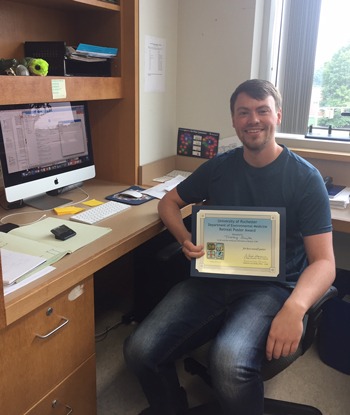
Tim Smyth
Congratulations to second year Toxicology graduate student Tim Smyth for winning an award for his poster and presentation at the annual Toxicology Retreat. Tim's poster was entitled "Diesel exhaust particles disrupt epithelial barrier function by altering tricellin expression".
Talk on Environmental Hazards at Home
Tuesday, June 13, 2017
Cait Fallone of the University’s Environmental Health Sciences Center and Jennifer Becker of the Finger Lakes Children’s Environmental Health Center will present “Could Your Home Be Making You Sick? Learn How to Stay Safe” from 12:10 to 12:50 p.m. Thursday, June 15, at the Rochester Central Library’s Bausch and Lomb Building, 115 South Ave. The lecture is part of a community health education series “Got Health?” co-sponsored by the Center for Community Health and the Central Library. Parking is available in the Court Street garage.
Grant Helps Build Understanding of Environmental Health with Hands-on Science Kits
Monday, June 12, 2017
A University of Rochester start-up company, Science Take-Out, LLC, has been awarded a nearly $1 million, two-year grant from the National Institutes of Health to further develop a line of hands-on environmental health science kits for use in community settings. The kits will help teachers and community educators increase the public’s understanding of how the environment can affect their health.
The Small Business Technology Transfer (STTR) Grant from the National Institute of Environmental Health Sciences (NIEHS) at the NIH will support modification of Science Take-Out’s current line of environmental health education kits for broader use.
Since 2008, Science Take-Out kits have provided a convenient and cost-effective way for teachers to incorporate engaging environmental health science activities into their classrooms. Now the kits, which align with national and state science education standards, will undergo a second round of extensive field testing to ensure they are relevant and accessible to diverse community audiences.
“Educating students and the general public about the link between the environment and their health allows them to make informed decisions and change their behavior to protect themselves from environmental exposures,” said Dina Markowitz, Ph.D., professor of Environmental Medicine, director of UR’s Life Sciences Learning Center.
Markowitz and Katrina Korfmacher, Ph.D., associate professor of Environmental Medicine and director of the Community Outreach and Engagement Core (COEC) at URMC’s Environmental Health Science Center, partnered to develop and test eight current environmental health kits, which range from lessons on breast cancer to lead poisoning prevention.
With the new award Markowitz and Korfmacher will collaborate with environmental health community outreach professionals from the University of North Carolina at Chapel Hill COEC, the University of Texas Medical Branch COEC, and West Harlem Environmental Action to adapt the kits for use outside of the classroom.
Slaughter Announces $524,000 Grant for Science Take-Out to Continue Environmental Health Education Initiative
Thursday, May 25, 2017
Congresswoman Louise Slaughter (NY-25) today announced a $524,883 federal award for Science Take-Out, a locally-based company that manufactures easy-to-use, hands-on science kits for students. This funding, administered by the Department of Human Health and Services’ (HHS) Small Business Technology Transfer (STTR) program, will expand on Science Take-Out’s successful STTR Phase I project that developed environmental health education kits for students in partnership with the University of Rochester’s Environmental Health Sciences Center.
“I’m so pleased to announce this federal funding for Science Take-Out to continue their important work educating kids and community members about science. At a time when science and fact are under siege, it is critical that organizations like this promote the building blocks of environmental education for our students. I’ve often said that Rochester is home to some of the brightest minds in the country and this is largely because of businesses like Science Take-Out, who help to inspire the next generation of researchers and environmental advocates with engaging, hands-on activities,” said Rep. Slaughter.
Currently, environmental health is typically covered minimally, if at all, in secondary school classrooms and there are also very few available hands-on activities that engage the general public in learning about concepts related to environmental health. Science Take-Out develops and manufactures innovative and easy-to-use hands-on science activity kits that are used in schools throughout the country. This new award will support Science Take-Out’s efforts to gather evidence on the impact of environmental health science kits on students’ learning and to modify the kits for use in diverse, community-based settings.
“Science Take-Out believes in the power of hands-on, experiential learning. That’s what our science kits do: provide students with the fun, easy-to-use tools they need to broaden their knowledge about science and health. We are a team of experienced science educators always looking for more ways to engage young students and this grant will go a long way in supporting that mission. Thank you, Congresswoman Slaughter, for your support of federal investments in research and science education,” said Dina Markowitz, president of Science Take-Out and professor of Environmental Medicine at the University of Rochester.
This funding expands Science Take-Out’s successful STTR Phase I project that developed and pilot-tested eight hands-on Science Take-Out kits on topics in environmental health science in partnership with the University of Rochester’s Environmental Health Sciences Center. These kits aid students in learning important health concepts such as: the biological effects of lead, sun and pesticide poisoning and health issues associated with antimicrobial agents found in consumer products.
Children with elevated lead levels aren't being tested or diagnosed, study says
Thursday, April 27, 2017
In the United States, pediatric health care providers are not doing enough testing of children's blood lead levels in many states, according to a study published Thursday in the journal Pediatrics.
When 38 states and the District of Columbia reported cases of elevated blood lead levels to the US Centers for Disease Control and Prevention from 1999 to 2010, most reported fewer than half of the numbers that were expected, the new study says. (An elevated blood lead level is considered to be greater than or equal to 10 micrograms per deciliter.)
Katrina Smith Korfmacher, associate professor in the Department of Environmental Medicine at the University of Rochester Medical Center, agreed that the historical focus of public health discussions of lead poisoning has been on the Northeast "due to the high concentrations of older housing in poor condition."
"Although this study may focus attention on the potentially unidentified children at risk in other areas, the need to reduce lead hazards in areas with large amounts of older housing remains critical," said Korfmacher, who was not involved in the new research.
DeLouise Gives Rochester Science Cafe Talk
Tuesday, March 28, 2017
Dermatology associate professor, Lisa DeLouise, MD, MPH, gave a 'Science Cafe' talk last night entitled, "Skin and the Environment: Things You Should But Probably Don't Know".
The DeLouise Bio Nanomaterials Group manipulates materials on the micro, nano and molecular level scales to design biomedical devices for diagnostic, therapeutic and investigative studies of skin. Our multidisciplinary approach integrates experimental research and simulation to design devices that exploit the novel optical, morphological and surface chemical properties of nanostructured materials. Key focus areas include optical biosensing, microfluidic cell sorting and cell culture and nanoparticle skin penetration, skin imaging, translocation and targeted delivery.
Science Cafes are interactive events involving face-to-face conversations with leading scientists about relevant current topics. This one meets on the fourth Tuesday of the month in the Community Room on the second Floor of the Pittsford Plaza Barnes and Noble.
Rahman Receives Senior Toxicologist Award From The Society of Toxicology
Tuesday, March 14, 2017
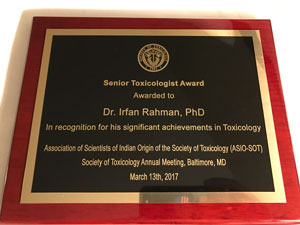
Irfan Rahman, Ph.D., Professor of Environmental Medicine, has been awarded a Senior Toxicologist Award by the Society of Toxicology - Associations of Scientists of Indian Origin. The award was presented to Dr. Rahman in the presence of many Society of Toxicology (SOT) meeting attendees as well as several NIEHS officials.
He received the award at the SOT 56th Annual Meeting and ToxExpo in Baltimore, MD on March 13th. This year's meeting, like its predecessors, was designed to provide members with access to cutting-edge science, networking opportunities, and career development resources through its various events and activities:
- 160+ Scientific Sessions, covering diverse topics such as age- dependent neuroimmunotoxicological effects, cardiopulmonary consequences of gestational toxicant exposure, and novel in vitro and in silico platforms, among dozens of others
- 50+ receptions and social events hosted by SOT Regional Chapters, Special Interest Groups, Specialty Sections, Committees, and other toxicology-related organizations
- 13 Continuing Education courses and other education opportunities
- ToxExpo, featuring more than 330 exhibitors providing products, services, and technology created to benefit the toxicology community
Congratulations Dr. Rahman!
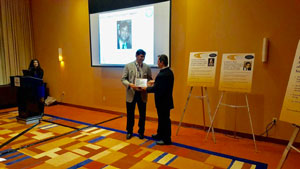
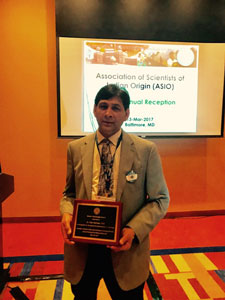
Irfan Rahman Studies Respiratory Risk of E-Cigarette Flavorings
Tuesday, February 21, 2017
The label may say "cinnamon" or "vanilla" but the true contents of e-cigarette flavorings are acetoin, diacetyl, and other chemical additives that are known to irritate the respiratory tract and impair lung function, according to a collaborative study from western New York scientists.
Senior author Irfan Rahman, Ph.D., professor of Environmental Medicine and part of the Lung Biology and Disease Program, said the findings suggest that chemical flavorings in e-cigarettes not only cause inflammation but may rapidly impair the critical epithelial cells in the airways, which act as the first defense against infections and toxins. When the epithelial barrier becomes more permeable or leaky due to chemical assaults, life-threatening lung diseases can occur.
For example, volatile flavoring chemicals (such as the butter flavor in microwave popcorn) have been linked to severe lung diseases among workers at food manufacturing plants who were routinely exposed during production, according to the Centers for Disease Control.
The local study was published by the journal, Applied In Vitro Toxicology. Janice Gerloff, a technician in Rahman's laboratory, and Isaac Sundar, Ph.D., a research assistant professor at URMC, worked with chemists and engineers at the Rochester Institute of Technology and the University at Buffalo to study the chemical characteristics of a sampling of flavored liquids used in vape pens, e-hookahs, e-cigars, e-pipes obtained from local vape shops. More than 450 brands of e-cig products with more than 8,000 flavors (including chocolate, menthol, mango, and cotton candy) are on the market, the study said.
Although the Flavor Extracts Manufacturers Association has certified these chemicals as safe, scientists are concerned about consumers inhaling them in high concentrations. Many e-cig flavors also are laced with nicotine. Researchers tested the emissions of flavored liquids and created a "puff profile" and a chemical profile for each flavor. They also treated human lung cells with the vaping chemicals and observed a potent reaction as pro-inflammatory cells transformed lung epithelial cells, making them more vulnerable to injury and illness.
The U.S Food and Drug Administration, Center for Tobacco Products, funded the research.
Cory-Slechta Named Distinguished Neurotoxicologist 2017
Monday, February 13, 2017
 The Society of Toxicology (SOT) Neurotoxicology Specialty Section (NTSS) Awards Committee has selected Dr. Deborah Cory-Slechta as the recipient of the Distinguished Neurotoxicologist Award. This award will be presented at the NTSS Reception that will be held on Wednesday, March 15, 2017 at the Hilton Baltimore Key Ballroom 6.
The Society of Toxicology (SOT) Neurotoxicology Specialty Section (NTSS) Awards Committee has selected Dr. Deborah Cory-Slechta as the recipient of the Distinguished Neurotoxicologist Award. This award will be presented at the NTSS Reception that will be held on Wednesday, March 15, 2017 at the Hilton Baltimore Key Ballroom 6.
Dr. Cory-Slechta has demonstrated a life-long commitment to neurotoxicology. She has been a pioneer in championing neurotoxicology and behavioral science, and in exploring the interactions of chemical and non-chemical stressors to understand the complex etiology of behavioral diseases. This research is highlighted, for example, in experimental work confirming that low-level lead exposure alters neurodevelopment, which was highly influential in setting federal guidelines for developmental lead exposures. Her more recent research including that on the interactions between air pollution exposure and socioeconomic stress on neurodevelopment also promises to be highly influential. In addition, Dr. Cory-Slechta has served extensively in a variety of administrative roles including as Department Chair, Institute Director, and Dean for Research at two prominent academic programs on occupational and environmental health. She also has served on numerous federal advisory panels and as an Officer and President of the NTSS. This overall record of research accomplishments and service marks a singularly distinguished career in neurotoxicology that is recognized by this award.
The committee considered three superb nominations for the Distinguished Neurotoxicologist Award. The review panel (Drs. William Boyes (chair), Michelle Block, Aaron Bowman, Steven Lasley, and Marion Ehrich) carefully evaluated these nominations relative to contributions to the science of neurotoxicology, the use of neurotoxicological science in making risk assessment and regulatory decisions, and service to the NTSS and the field of neurotoxicology. All three nominees were outstanding, exceptionally accomplished, and each has made strong contributions to neurotoxicology. Unfortunately, in any one year we are able to select only one individual for the Distinguished Neurotoxicologist Award.
The Neurotoxicology Specialty Section (NTSS) has a rich history of outstanding scientists advancing our field through research, regulatory, and service accomplishments. In the past, NTSS has recognized four scientists as Distinguished Investigators in the field of Neurotoxicology from 2001 through 2006 and Dr. Joan Cranmer in 2008 for Distinguished Service to Neurotoxicology. However, despite many accomplished scientists contributing greatly and in a variety of ways to the field, this award has been dormant since 2008. In an effort to establish a continuous mechanism to acknowledge the top leaders in our field, the NTSS leadership reinstated a career recognition award, now called the Distinguished Neurotoxicologist Award. This year, we established clear criteria, defined procedures, encouraged nominations, and convened a committee to evaluate applications. For those interested, the details of this process can be found on the NTSS website.
Congratulations to Dr. Cory-Slechta!
Evidence Points to Fish Oil to Fight Asthma
Thursday, February 9, 2017

University of Rochester Medical Center scientists have discovered new essential information about omega 3 fatty acids contained in fish oil and how they could be used for asthma patients.
In a paper published in the Journal of Clinical Investigation—Insight, researchers using cell cultures from local asthma patients, found that:
- Omega-3 fatty acid products can reduce the production of IgE, the antibodies that cause allergic reactions and asthma symptoms in people with milder cases of asthma
- But in patients with severe asthma who use high doses of oral steroids, the omega-3 fatty acids are less effective because the corticosteroids block the beneficial effects
Lead author Richard P. Phipps, Ph.D., the Wright Family Research Professor of Environmental Medicine, and his lab had previously shown that certain fatty acids contained in fish oil regulate the function of immune cells (B cells). They wanted to further investigate the effects on asthma.
People with asthma have an imbalance between molecules that dampen inflammation and those that increase inflammation. Using steroids as treatment controls the inflammation and relieves symptoms, but does not cure the underlying disease.
Georas receives endowed Professorship
Wednesday, February 1, 2017
Thanks to the exceptional generosity of Walter Parkes and family, Dr. Georas was named the Walter and Carmina Mary Parkes Family Professor in 2017. This position will allow the Georas Lab to expand into new directions and accelerate research into new treatments for patients suffering from asthma.
Rahman's Recent Paper Featured on Cover of American Journal of Respiratory Cell and Molecular Biology
Thursday, January 19, 2017

Enviromental Medicine professor, Irfan Rahman's paper, Shelterin Telomere Protection Protein 1 Reduction Causes Telomere Attrition and Cellular Senescence via Sirtuin 1 Deacetylase in Chronic Obstructive Pulmonary Disease , has been chosen to be featured on the January cover of the journal of American Journal of Respiratory Cell and Molecular Biology. The cover (see image to the right) includes a diagram is from the Rahman group's data figure showing human telomere damage by environmental tobacco smoke during lung aging and COPD disease.
Congratulations to Dr. Rahman and his lab!
